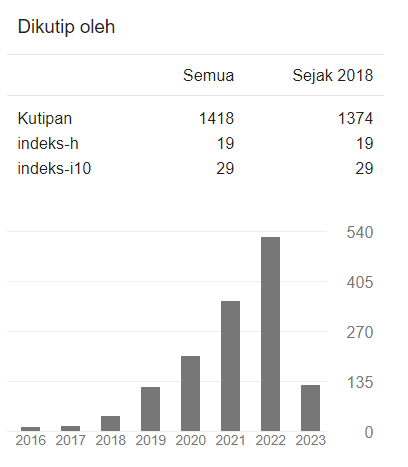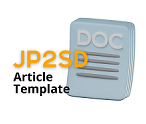Creativity of Elementary School Students Based on The Description Text Writing Skill
DOI:
https://doi.org/10.22219/jp2sd.v9i2.18108Abstract
Unique ideas in writing the description text can foster creativity for students, where one of the goals of writing is to train creativity through writing habits. Therefore, the purpose of this study was to describe the creativity of elementary school students based on their ability to write descriptive text. This research was a qualitative descriptive study with data collection procedures through tests and interviews. The subjects of this study were three of fifth grade students of SDN 1 Sei Teras Kapuas Kuala, each of whom wrote good, fair, and poor. Each category analyzed to determine their level of creativity. The results showed that students with good description text categories fulfilled the high level of creativity, the students with fairly description text categories and poorly description text categories fulfilled the medium level of creativity.
Downloads
References
Andheska, Harry. 2016. “Membangun Kreativitas Siswa Dalam Pembelajaran Menulis Dengan Memanfaatkan Media Pembelajaran Inovatif.” Jurnal Bahastra 36(1): 55–67.
D’Souza, Richard. 2021. “What Characterises Creativity in Narrative Writing, and How Do We Assess It? Research Findings from a Systematic Literature Search.” Thinking Skills and Creativity: 100949.
Dafit, Febrina. 2017. “Keefektifan Kemampuan Menulis Kreatif Siswa SD Dengan Model Pembelajaran Multiliterasi.” GERAM 5(1): 49–57.
Dalman, Haji. 2021. Keterampilan Menulis. PT. RajaGrafindo Persada.
Haerazi, Haerazi, Lalu Ari Irawan, Taufik Suadiyatno, and Heri Hidayatullah. 2020. “Triggering Preservice Teachers’ Writing Skills through Genre-Based Instructional Model Viewed from Creativity.” International Journal of Evaluation and Research in Education 9(1): 234–44.
Istianah, Tia Nur. 2020. “Power (Plan, Organize, Write, Edit, and Revise) Strategy: Teaching Writing Viewed from Students’ Creativity.” Diadikasia Journal 1(1).
Istiq’faroh, Nurul, and Ali Mustadi. 2020. “Improving Elementary School Students’ Creativity and Writing Skills through Digital Comics.” Ilkogretim Online 19(2).
Jannah, Eka Mufidah Nur, Heri Suwignyo, and Titik Harsiati. 2019. “Analisis Nilai-Nilai Karakter Hasil Karya Menulis Kreatif Siswa.” Jurnal Pendidikan: Teori, Penelitian, dan Pengembangan 4(2): 149–55.
Krasteva, Antoniya. 2017. “The Program ‘Develop of the Critical Thinking through Reading and Writing’–Contemporary Necessity in Pedagogy.” 11(1): 16–36.
Lubis, Silvia Sandi Wisuda. 2017. “Keterampilan Menulis Essai Dalam Pembentukan Berpikir Kritis Mahasiswa Prodi PGMI UIN Ar-Raniry Banda Aceh.” PIONIR: Jurnal Pendidikan 6(2).
Rafiah, Hajjah. 2017. “Impelentasi Kegiatan Menulis Pada Pembelajaran Matematika Untuk Meningkatkan Kreativitas Mahasiswa PGSD.”
———. 2019. “Strategi Pemecahan Masalah Open-Ended Siswa Berpikir Kreatif Matematis Tinggi.” Lentera: Jurnal Pendidikan 14(2): 75–83.
Rivers, Wilga M. 2018. Teaching Foreign Language Skills. University of Chicago Press.
Sardila, Vera. 2016. “Strategi Pengembangan Linguistik Terapan Melalui Kemampuan Menulis Biografi Dan Autobiografi: Sebuah Upaya Membangun Keterampilan Menulis Kreatif Mahasiswa.” An-Nida’ 40(2): 110–17.
Schmoelz, Alexander. 2018. “Enabling Co-Creativity through Digital Storytelling in Education.” Thinking Skills and Creativity 28: 1–13.
Tabelessy, Novita. 2019. “Kreativitas Menulis Karangan Persuasi Siswa SMP.” Jurnal Tahuri 16(2): 35–46.
Viollita, Ketrin, Patuan Raja, and Ari Nurweni. 2018. “Implementing Schoology in Blended Learning Environment and Its Relation to Creativity in Writing.” U-JET 7(5).
Wicaksono, Andri. 2014. Menulis Kreatif Sastra: Dan Beberapa Model Pembelajarannya. Garudhawaca.
Witanto, Janan. 2018. “Minat Baca Yang Sangat Rendah.” Publikasi. Fakultas Keguruan dan Ilmu Pendidikan Universitas Kristen Satya Wacana Salatiga.
Downloads
Published
Issue
Section
License
Copyright (c) 2021 Jurnal Pemikiran dan Pengembangan Sekolah Dasar (JP2SD)

This work is licensed under a Creative Commons Attribution-ShareAlike 4.0 International License.
Authors who publish with Jurnal Pemikiran dan Pengembangan Sekolah Dasar (JP2SD) agree to the following terms:
- For all articles published in Jurnal Pemikiran dan Pengembangan Sekolah Dasar (JP2SD), copyright is retained by the authors. Authors give permission to the publisher to announce the work with conditions. When the manuscript is accepted for publication, the authors agree to automatic transfer of the publishing right to the publisher.
- Authors retain copyright and grant the journal right of first publication with the work simultaneously licensed under a Creative Commons Attribution-ShareAlike 4.0 International License that allows others to share the work with an acknowledgment of the work's authorship and initial publication in this journal.
- Authors are able to enter into separate, additional contractual arrangements for the non-exclusive distribution of the journal's published version of the work (e.g., post it to an institutional repository or publish it in a book), with an acknowledgment of its initial publication in this journal.
- Authors are permitted and encouraged to post their work online (e.g., in institutional repositories or on their website) prior to and during the submission process, as it can lead to productive exchanges, as well as earlier and greater citation of published work (See The Effect of Open Access).

This work is licensed under a Creative Commons Attribution-ShareAlike 4.0 International License.


















